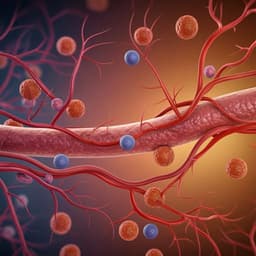
Psychology
Working memory training improves episodic memory in older people: transfer based on controlled retrieval processes
P. Zamarreño, P. M. Mateos, et al.
This study, conducted by Patricia Zamarreño, Pedro M. Mateos, and Alberto Valentin, shows that adaptive complex span working memory training improved episodic recognition in older adults — but only when tests required controlled recollection, underscoring the importance of matching cognitive processes for effective interventions.
~3 min • Beginner • English
Introduction
Episodic memory, the ability to recall past events, is particularly vulnerable to aging and impacts daily functioning in older adults. Prior WM training studies report mixed far-transfer effects to episodic memory, possibly because transfer requires overlap in underlying cognitive/neural processes between training and outcome tasks. The dual-component WM model (Unsworth & Engle, 2007) posits active attentional control maintaining items in primary memory and controlled search retrieving displaced items from secondary memory. Complex span tasks engage both, as processing demands push items to secondary memory, requiring controlled retrieval. The present study tests the hypothesis that WM training will transfer to episodic memory only when the memory test requires controlled retrieval (recollection), not when familiarity can suffice. Using inclusion/exclusion (verbal) and global/local (visuospatial) recognition paradigms to dissociate recollection and familiarity, the authors predicted EG > CG improvements from pre- to post-test specifically in exclusion/local (recollection-dependent) conditions. A secondary aim assessed near transfer to other WM tasks (reading span; backward digit and spatial spans).
Literature Review
Reviews and meta-analyses show inconsistent WM training efficacy for global cognition and episodic memory in older adults. Some studies report benefits while others do not, or find task-specific gains. Methodological factors may contribute, but theory suggests transfer requires shared processes between training and outcome measures. The Unsworth & Engle (2007) dual-component model highlights attentional control and controlled retrieval from secondary memory in complex span tasks. Recognition tests using process-dissociation (inclusion/exclusion) or local/global paradigms can separate recollection from familiarity contributions to performance. Prior correlational work links WM capacity to recollection (but not familiarity) estimates in recognition tasks, suggesting that improvements in controlled retrieval could mediate far transfer. The present work builds on these insights by experimentally testing transfer contingent on recollection demands.
Methodology
Design: Double-blind randomized controlled trial with repeated measures (pre-test, post-test). Participants: 60 community-dwelling adults aged >60 initially enrolled; 5 excluded (suspected severe depression, suspected cognitive impairment, medication affecting cognition, and two with low training attendance), yielding N=55 (EG=27; CG=28). Groups were similar in age, mood, global cognition, memory complaints; CG had more years of schooling (p=0.05); gender distribution did not differ. Setting: Senior centers and neighborhood associations in Salamanca, Spain. Ethics: University of Salamanca Bioethics Committee approval; informed consent obtained. Procedure: Approximately 1 week pre-training, participants completed demographic and baseline assessments; 1 week post-training, they completed the same cognitive assessments in a fixed order. Training: 10 group sessions over 5 weeks, 2 per week, ~50 minutes each; 7 tasks per session (~6–7 minutes/task); order varied by session. Experimental group WM training: Seven adaptive complex span tasks (4 verbal: counting span, digit span, operation span, lexical span; 3 visuospatial: matrix span, alignment span, rotation span) implemented in E-Prime 2. Each trial comprised serial item presentation (digits, letters, locations) interleaved with an interfering processing task (e.g., number comparison, arithmetic, lexical decision, symmetry judgment, alignment, rotation). Difficulty adapted by algorithm based on serial recall accuracy and ≥80% processing-task performance across 5 blocks (3 trials/block); initial span length of 2 items; feedback provided after blocks. To promote secondary memory retrieval, trials ended with the processing task, preventing the last item from remaining in primary memory. Early sessions simplified format (separate stages) and started without time limits; from session 3, timing was 1000 ms per item and 3000 ms per processing task (timed later for matrix/rotation starting session 5). Inter-trial interval was participant-controlled. Control group pseudo-training: Seven non-adaptive perceptual speed-like tasks (4 verbal, 3 visuospatial) in E-Prime without time constraints and with difficulty uniformly increasing across sessions independent of individual performance; designed to match expectations and contact time without targeting WM or episodic memory. Assessments (paper-and-pencil): Demographics; mood (Spanish Yesavage GDS), global cognition (Spanish MMSE), subjective memory complaints; Episodic memory: Verbal recognition test (two studied lists A/B from distinct semantic categories with one shared category; two versions counterbalanced; study: 18 words/list including fillers to mitigate primacy/recency; test phases: Inclusion—recognize items from either list vs new; Exclusion—recognize only List A, reject List B and new). Words selected from Spanish norms (category control and lexical availability; low-availability new items to reduce false alarms). Visuospatial recognition test (two versions; study: 16 target geometric images and 4 fillers presented in one of four quadrants; recognition phases: Global—old/new judgments with centered images; Local—judge same-quadrant occurrences vs different-quadrant or new; practice with shortened version provided). Working memory: Reading span (Spanish adaptation), backward digit span, backward spatial location span (WMS). Administration included all difficulty levels in randomized orders (two orders counterbalanced across pre/post); scoring used partial-credit unit scoring, averaging across levels (0–1 scale). Data processing and analysis: Recognition sensitivity derived from signal detection theory: d′(n)=z(Hits)−z(False Alarms) for inclusion/global; d′(i)=z(Hits)−z(False Intrusions) for exclusion/local. Primary analyses used mixed ANOVAs: Group (EG vs CG) × Session (pre vs post) with α=0.05; ANCOVA added years of schooling when indicated. Training gains evaluated via paired t-tests (session 2 vs session 10) with Bonferroni correction; effect sizes used Cohen’s d with Hedges–Olkin correction. Software: IBM SPSS v26.
Key Findings
Training task gains (EG only): Significant performance gains across all seven complex span training tasks from session 2 to 10: overall t(26)=10.70, p<0.001, d=2.00; verbal tasks t(26)=9.56, p<0.001, d=1.79; visuospatial tasks t(26)=7.29, p<0.001, d=1.36. Individual tasks significant (all p≤0.005 after Bonferroni): counting span t=8.54, d=1.60; digit span t=6.31, d=1.18; lexical span t=7.31, d=1.37; operation span t=4.48, d=0.84; alignment span t=10.46, d=1.95; matrix span t=2.80, d=0.52; rotation span t=3.56, d=0.67. Far transfer – Verbal recognition: Exclusion condition (recollection; d′(i)): Group×Session interaction marginal by ANOVA, F(1,53)=3.908, p=0.053, η²=0.069; with years of schooling as covariate, ANCOVA confirmed interaction, F(1,52)=5.538, p=0.022, ηp²=0.096, indicating greater pre-to-post improvement in EG vs CG. Inclusion condition (familiarity+recollection; d′(n)): No interaction F(1,53)=0.067, p=0.797; no main effects of session or group. Far transfer – Visuospatial recognition: Local condition (recollection; d′(i)): Significant Group×Session interaction, F(1,53)=6.395, p=0.014, ηp²=0.108; EG showed greater improvement than CG; session main effect F(1,53)=20.891, p<0.001. Global condition (familiarity+recollection; d′(n)): No interaction F(1,53)=1.093, p=0.300; no main effects. Near transfer – Working memory tests: Reading span: Significant Group×Session interaction, F(1,53)=5.683, p=0.021, ηp²=0.097; session main effect F(1,53)=21.551, p<0.001. Backward digit span: No interaction F(1,53)=1.505, p=0.225; no main effects. Backward spatial location span: No interaction F(1,53)=0.634, p=0.429; no session main effect; group main effect F(1,53)=7.711, p=0.008. Effect sizes for pre–post within-group changes (Hedges-corrected): EG large effects in visuospatial local d′(i) (d=0.906), verbal exclusion d′(i) (d=0.882), and reading span (d=0.860); small in digit span (d=0.145) and spatial location (d=0.237). CG small effects in visuospatial local (d=0.275), verbal exclusion (d=0.412), reading span (d=0.319), digit span (d=−0.188); medium in spatial location (d=0.522).
Discussion
Results support the process-overlap account of transfer: WM training on complex span tasks improved episodic recognition specifically when performance required controlled retrieval (recollection) and not when familiarity could support performance. EG participants better resisted intrusions in exclusion/local conditions by retrieving item–context bindings, consistent with enhanced controlled search from secondary memory posited by the dual-component WM model. No transfer emerged in inclusion/global conditions where familiarity contributes, aligning with predictions. Near transfer occurred for the complex reading span task but not for backward digit or spatial spans, suggesting that gains preferentially affect tasks sharing interference and controlled retrieval demands typical of complex span paradigms. Potential influences of educational background were addressed via covariate adjustment, which confirmed the verbal recognition effect. The pattern underscores that successful transfer depends less on superficial task similarity and more on shared cognitive mechanisms—here, controlled retrieval—between training and outcome tasks. The discussion also notes that the absence of effects on simple backward spans may reflect lower demands on secondary-memory retrieval compared to complex spans, and highlights open debates on whether backward spans index WM vs short-term memory. Broader implications emphasize targeting specific mechanisms to design effective interventions for aging populations, with evidence also suggesting bidirectional links between episodic retrieval training and WM performance in related literature.
Conclusion
This study demonstrates that adaptive complex span working memory training in older adults transfers to episodic memory performance when the outcome tasks require controlled retrieval (recollection), as shown by gains in exclusion/local recognition conditions for verbal and visuospatial materials. Transfer did not occur in inclusion/global conditions where familiarity contributes. Near transfer was observed for a complex reading span measure but not for backward digit or spatial spans. These findings argue for designing cognitive interventions that explicitly target and share critical processes—such as controlled retrieval—from training to transfer tasks. Future research should replicate with larger and more gender-balanced samples, refine verbal materials to avoid ceiling effects, explore the role of task content (verbal vs spatial), and systematically test other candidate shared mechanisms (e.g., updating, attentional control) to optimize cognitive training efficacy in older adults.
Limitations
- Sample size was relatively small, limiting power and generalizability; replication with larger samples is needed. - Gender imbalance (more women than men) may limit generalization, especially given potential sex differences in brain aging. - Verbal recognition used low lexical-availability intrusions, producing near-ceiling performance and potentially masking effects; future versions should include higher-availability lures. - Groups differed in years of schooling (CG > EG); although ANCOVA addressed this for verbal recognition, residual confounding cannot be fully excluded. - Transfer to simple backward spans was absent, raising questions about task sensitivity and construct coverage of WM measures. - Active control tasks lacked time pressure (pseudo–perceptual speed), which may not fully match engagement or cognitive load characteristics of the experimental training.
Related Publications
Explore these studies to deepen your understanding of the subject.







